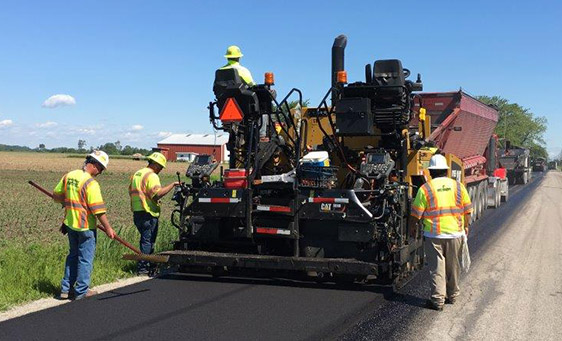Make Best Use Of Area Performance with Hot Mix Asphalt Angled Parking Lot Solutions
Make Best Use Of Area Performance with Hot Mix Asphalt Angled Parking Lot Solutions
Blog Article
Opening the Keys of Hot Mix Asphalt Technology
Checking out the depths of hot mix asphalt innovation discovers a world where careful procedures and accurate solutions converge to shape our roadways and facilities. The combination of fillers, binders, and accumulations isn't just a building and construction task but a tactical orchestration of durability and efficiency. As we peer right into the complex dance of components, a tapestry of strength and sustainability unfolds. What lies below this surface of asphaltic mastery, and what secrets wait to be introduced in the realm of leading technologies?
Significance of Warm Mix Asphalt
Hot Mix Asphalt plays a vital role in modern-day facilities development because of its sturdiness and cost-effectiveness. As the most frequently made use of leading material for roads, freeways, and parking area, Hot Mix Asphalt supplies a series of benefits that add to its significance in building and construction projects. One crucial benefit is its capacity to stand up to rush hour lots and extreme climate condition, supplying a durable and reputable surface for transportation networks. In Addition, Warm Mix Asphalt is affordable in both first building and construction and long-lasting upkeep, making it a recommended selection for numerous infrastructure projects.
The longevity of Warm Mix Asphalt stems from its structure, which consists of aggregates, binder, and filler products that are very carefully chosen and mixed to satisfy certain performance needs. On the whole, the importance of Warm Mix Asphalt in infrastructure growth can not be downplayed, as it continues to be a keystone of contemporary construction techniques.
Elements of Asphalt Mixes
The structure of asphalt blends consists of meticulously chosen aggregates, binder, and filler products that are critical for accomplishing details efficiency requirements. Aggregates are the main component of asphalt mixes, giving stamina and stability. These accumulations can be natural, such as gravel or smashed stone, or synthetic, like recycled products from old pavements. The binder, generally asphalt or asphalt concrete, holds the accumulations with each other and offers flexibility and sturdiness to the mix. The option of the binder is essential as it straight affects the mix's efficiency in various weather. Fillers, such as moisturized lime or Rose city concrete, are made use of to improve the mix's workability and aging resistance. Angled Parking.
The combination and proportion of these parts play a considerable function in establishing the quality and performance of the asphalt mix. Designers thoroughly develop the mix to satisfy certain demands, thinking about aspects like traffic quantity, environment problems, and sidewalk life-span. Proper selection and harmonizing of accumulations, binder, and fillers are crucial for creating long lasting, resilient asphalt pavements.
Mixing and Manufacturing Techniques

When the accumulations are selected, the binder, frequently asphalt cement, is included to bind the materials with each other. The binder's quality and amount dramatically affect the mix's stamina, resistance, and flexibility to environmental aspects. Furthermore, fillers like hydrated lime or Portland cement might be included to improve particular attributes of the asphalt mix, such as its workability or wetness resistance.
Throughout manufacturing, the aggregates and binder are heated up, normally between 250-325 ° F(121-163 ° C ), to help with mixing and ensure correct finishing of the accumulations. The mixing process has to be comprehensive to achieve an uniform blend that promotes the desired efficiency attributes of the asphalt. Various techniques, such as batch blending or drum blending, are utilized to accomplish regular and top quality asphalt blends for building projects.
Aspects Impacting Asphalt Efficiency
Aspects affecting asphalt efficiency encompass a variety of variables that influence the longevity, long life, and total quality of asphalt sidewalks. One essential element is the top quality of materials utilized in the asphalt mix.

Style factors to consider, such as pavement density and drainage, are essential in making certain the long-term efficiency of the asphalt pavement. By thoroughly considering these specialists, factors and engineers can enhance asphalt efficiency and boost the solution life of pavements.
Sustainable Practices in Asphalt Modern Technology

In addition, the growth of warm-mix asphalt (WMA) modern technologies has gained grip over the last few years. WMA permits for the manufacturing and placement of asphalt blends at reduced temperatures contrasted to traditional hot-mix asphalt, resulting in reduced power usage and greenhouse gas emissions. Additionally, using permeable asphalt blends can aid reduce stormwater overflow issues by permitting water to infiltrate through the pavement and into the ground, advertising all-natural water filtration and reenergize processes. By executing these lasting methods, the asphalt industry can add to constructing a much more eco friendly and durable infrastructure network.
Final Thought
Finally, hot mix asphalt technology plays a crucial duty in contemporary facilities development as a result of its sturdiness and cost-effectiveness. By meticulously stabilizing parts, using correct blending strategies, and taking into consideration various aspects, designers can develop high-grade asphalt blends that endure heavy traffic loads and extreme weather condition problems. Accepting sustainable practices, such as using warm-mix modern technologies and recycled hot mix asphalt products, further boosts the ecological friendliness of asphalt innovation.
Blending and production techniques in hot mix asphalt innovation include the accurate combination and handling of aggregates, binder, and fillers to create a sturdy and high-performance asphalt mix.Aspects influencing asphalt efficiency encompass an array of variables that affect the sturdiness, longevity, and general quality of asphalt sidewalks. Sustainable techniques in asphalt technology include various campaigns aimed at reducing the ecological impact of asphalt manufacturing and paving processes. By incorporating recovered asphalt pavement (RAP) and recycled asphalt tiles (RAS) into brand-new asphalt mixes, the market can substantially minimize the usage of raw materials and energy, while additionally decreasing landfill waste.
WMA enables for the production and positioning of asphalt blends at reduced temperature levels contrasted to standard hot-mix asphalt, resulting in reduced energy usage and greenhouse gas emissions.
Report this page